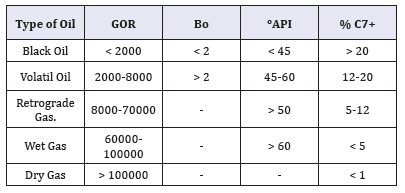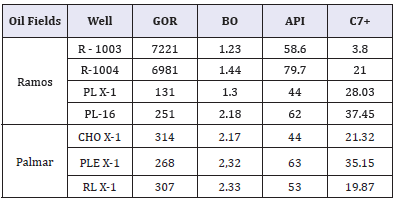- Submissions

Full Text
Progress in Petrochemical Science
Oil Types of the Norwest Basin of Argentina
L Ale Ruiz1*, J Lezama1, A Riveros Zapata2 and JP Gutierrez3
1 Faculty of Engineering, National University of Salta, Argentina
2 Faculty of Engineering, INBEMI, National University of Salta, Argentina
3 Technological Institute of Buenos Aires- ITBA, CONICET, Argentina
*Corresponding author: L Ale Ruiz, Faculty of Engineering, Research Council, National University of Salta, Argentina
Submission: April 04, 2018;Published: April 17, 2018

ISSN 2637-8035Volume1 Issue4
Introduction
Prior to producing a hydrocarbon deposit, performing a PVT study is necessary so that, based on the results of the studies, the various parameters and methodologies that will be developed to produce the deposit are determined. The PVT study is absolutely necessary in order to design the production facilities; in parallel, with this information the POES (Original Petroleum In Site) of the oilfield, the productive life of the deposit and the optimal production schemes are determined, in addition to evaluate methods of improved recovery of hydrocarbons and others properties that predict the behavior of the wells as they are exploited.
One part of the PVT study, the compositional one, is of great importance in the engineering of oilfields, since it helps to characterize the oilfield type and the volumetric conditions in which the oil is found, through the analysis of its behavior (volumetric and compositional), in order to establish the best strategy of exploitation and separation on the surface. This study involves a set of laboratory analysis of the samples, one of which is the differential expansion of the fluid sample to determine the Bo (volumetric factor of oil formation) and RPG or GOR (gas-oil relationship), this last ones are essential to classify oil in situ, in addition to the API gravity.
One of the most important indicators is the GOR, which is the amount of associated gas separated during production, by obtaining oil at atmospheric pressure, dividing by the amount of crude remaining. It indicates how much gas there is for each barrel of crude, at standard conditions (60 ͦF, 14.7 psi). The API gravity: is a specific gravity scale developed by the American Petroleum Institute (API), to determine the relative density of oil and its derivatives; it’s expressed in API degrees, and is inversely proportional to the specific gravity. The Bo compares the volumes of crude and gas dissolved in the oilfield versus the volume of that crude on the surface (at standard conditions).
Based on this information, the different types of crude (Pirson [1]) are classified in:
i. Black Oil
ii. Volatile Oil
iii. Retrograde Oil
iv. Wet Oil
v. Dry Gas
In addition to the mentioned properties, the amount of heavy hydrocarbons that contain the crude is decisive (% C7+), also called heavy fraction. In Table 1, the values of the properties for each type of crude are presented [2]. The objective of this paper is to show that if we classify oil crudes taking into account only one property, mistakes can be made, which can lead to serious problems in the design of surface equipment.
Table 1:Oil clasification.

Methods
Table 2:Data of wells in the northern area of Argentina.

Information was collected from an oil company, which operates in the Northern area of the Province of Salta and Formosa, from the PVT analysis from one of its wells. Table 2 summarizes the relevant data for the classification of crude oil. With this data, the classification of the crudes was done, taking into account one property and then considering all the properties. (Table 3 & 4) show the results of the classification based on the GOR, BO, API and C7+ respectively [3-7].
Table 3:Classification of the crudes based on one property.

Table 4:Classification of the oils studied.

Results
The results presented in Table 3, show a classification very contrary to the characteristics of the oils from the north of the province of Salta, which in its majority are Volatile and Retrograde oils. They are even contrary to each other. As seen in Table 3, if the oils are classified considering a single property they give very different results. The correct thing to do is to consider the four properties together to classify the crudes according to the references from Table 1. This new and complete classification is shown in Table 4.
Conclusion
As can be see when doing the classification of oil it’s necessary to have the greatest number of properties to analyze since mistakes can be made, which bring about incorrect decisions in the completion of the well, in the exploitation and in the design of the surface facilities.
References
- Pirson S (1965) Ingeniería de yacimientos petrolíferos. Ediciones Omega, Barcelona, Spain.
- Dake LP (1978) Fundamenals of Reservoir Engineering. Elsevier
- John E (2017) Outlook on oil and gas. Deloitte Center for Energy Solutions.
- Fangming L, Zhongyuan T, Aming J, Xiaoxia W (2009) Prediction of reservoir depletion degree and production GOR using logging-while-drilling data. Petroleum Exploration and Development 36(5): 617-622.
- Liqiang S, Feng W, Jianhai M, Guoqing F, Hang Y (2014) Quantitative calculation of GOR of complex oil-gas-water systems with logging data: A case study of the Yingdong Oil/Gas Field in the Qaidam Basin. Natural Gas Industry B 1(2): 172-177.
- Lee W, Barger W (1996) Gas Reservoir Engineering. SPE 5: 349.
- Schlumberger Surenco SA (2018) Intelligent completion.
© 2018 L Ale Ruiz. This is an open access article distributed under the terms of the Creative Commons Attribution License , which permits unrestricted use, distribution, and build upon your work non-commercially.
 a Creative Commons Attribution 4.0 International License. Based on a work at www.crimsonpublishers.com.
Best viewed in
a Creative Commons Attribution 4.0 International License. Based on a work at www.crimsonpublishers.com.
Best viewed in 







.jpg)






























 Editorial Board Registrations
Editorial Board Registrations Submit your Article
Submit your Article Refer a Friend
Refer a Friend Advertise With Us
Advertise With Us
.jpg)






.jpg)













.bmp)
.jpg)
.png)
.jpg)














.png)

.png)



.png)






